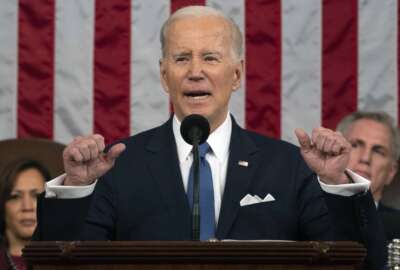Hubbard Radio Washington DC, LLC. All rights reserved. This website is not intended for users located within the European Economic Area.
Sequestration, sequestration, se — Wait, don’t summon the S-word!
Former Hill and federal executives recommend agency leaders to keep a close eye on the appropriations and be more proactive to protect against potential deep cu...
If the fiscal 2024 budget process was a baseball game, we’d still be in the early innings.
And like in baseball, where no lead is safe, what the bills look like today is far from what they will look like on Oct. 1 or Nov. 1 or even Jan. 1, whenever Congress passes, and the President signs, a final set of spending bills.
The one thing that seems certain, is lawmakers will not get the budget done by Oct. 1, leaving agencies with yet another continuing resolution and opening the door, ever so slightly, for the return of the “S” word — sequestration.
Just don’t say it more than three times, or like Beetlejuice, if you say it too often, it will appear out of the ether.
It’s been a decade since agencies faced that ugly “S” word, and 2013 was the first time since the 1980s.
If you aren’t familiar with the “S” word, then you probably were in college, high school or even the private sector back in 2013. But those of who were around and remember the “S” word, even the slight possibility of a return sends shivers down your spine.
“In 2013, agencies took a massive hatchet to their discretionary spending,” said Matthew Cornelius, a former Senate Homeland Security and Governmental Affairs staff member. “Broadly speaking, House Republicans are making different calculations today than they did in 2013 with the Budget Control Act.”
The Budget Control Act ushered in the “S” word — OK we can say it a second time, sequestration — and it required Obama administration leaders to cut discretionary spending by about $85 billion in 2013, which ended up being about a 7.8% cut to Defense agencies and a 5% cut to civilian agencies.
The pain of those cuts took years to rebound from, and even the possibility of it returning should force federal executives and industry leaders to stand up and take notice.
Self-imposed Jan. 1 deadline
The reason why you should even be thinking about the “S” word is if Congress doesn’t pass a 2024 spending bill by Jan. 1, the debt ceiling deal from June includes an automatic 1% across the board cut. While it may not technically be called the “S” word, the cut will be felt the same no matter.
“Lawmakers already are saying they are looking to get this done by Jan. 1,” said Mike Hettinger, president of Hettinger Strategies and a former House oversight committee staff member. “This leads me to believe they will try to do a CR sooner than later and get the final spending bill off the table to avoid the automatic cuts.”
Congressional watchers, however, say this doesn’t mean all is well in appropriations land.
Federal executives still should be keenly aware of the possibility of a cut to their program.
Hettinger said the difference between the initial versions of the House and Senate spending bill is about $100 billion. And this doesn’t even take into account what the Biden administration put forward in March.
“The biggest issues we are facing is not the House or Senate bill, but how they come to agreement when you have delta that is $80 billion to $110 billion difference?” Hettinger said. “In order to get a bill done, someone will have to blink and it’s not clear who that is. In recent memory, I don’t remember a delta that great. Usually it’s $15 billion-to-$20 billion between the two bills. This will be difficult to find a number to coalesce around.”
How to shore up your programs
And that is both the rub and concern that federal executives should be preparing for. It seems likely that cuts to programs, especially those Republicans labeled as “woke” are coming in one way, shape or form. These could include green government priorities such as electrifying the federal fleet or getting federal buildings to zero emissions.
Jeff Newman, an attorney with Thompson Coburn, said there are some programs or areas that likely are safe like national security, veterans and even things like cybersecurity and digital services.
“I don’t think agencies will see huge increases like we did in year’s past. It will be more of a reprioritizing of assets and monies to certain industries and programs and priorities that the government has both domestically and internationally,” Newman said. “Some of domestic programs you feel good about are likely in trouble, while you will see increases around things that support Ukraine’s war effort, the intelligence community and manufacturing and additive technologies to improve the supply chains of critical products.”
Over the next few months, federal executives and industry leaders should take some steps to shore up support for their programs.
Experts say first figure out how much attention Congress is giving to your program or area.
“Because of years of out-of-control spending, it has been and will continue to be my priority to pass conservative bills that focus our limited resources on the core responsibilities of the federal government, including national defense, our veterans and our border,” said House Appropriations Chairwoman Kay Granger (R-Texas) in a June 12 statement.
Emily Murphy, a former House Small Business and Armed Services staff member and administrator of the General Services Administration, said while it’s too soon for federal executives to panic, they need to act quickly to understand, what, if any are the concerns lawmakers have with your program.
Murphy recommended first talking to your agency’s Congressional Affairs office as they can be helpful to address specific concerns and ensure the messaging is consistent.
She also said executives should make sure they are a part of budget briefings and be available as a resource to answer questions from the Congressional Affairs office or from the hill.
Spend your 2023 funding
At the same time, Murphy, who now is a senior fellow with the Center for Government Contracting at George Mason University and consults with government contractors, said when she was a staff member on the Hill she always enjoyed hearing directly from federal employees.
“Congressional Affairs was fine, but I felt like I would get more candid answers without Congressional Affairs. At the same time, those conversations could get self serving too, especially if the employee was throwing another program under the bus,” Murphy said. “I kept a Rolodex of direct phone numbers and didn’t hesitate to reach out to program folks. Some would talk to me and others would say they have to go Congressional Affairs.”
She also cautioned against “freelancing” with Hill staff as it may cause your agency some unnecessary heartache.
Hettinger recommended working with OMB and your agency’s authorizing committees to make sure they know what your objections or concerns are about potential cuts to a program.
As for the rest of 2023, David Berteau, the president of the Professional Services Council and a former DoD assistant secretary of Defense for logistics and materiel readiness, offered these considerations.
First, program officials should spend the money they have in 2023. A CR heading into 2024 means no new starts, but agencies can continue initiatives begun previously.
Second, plant the seeds that will grow into the out years like 2025 and beyond.
“Under the debt limit deal, agencies could only see as much as a 1% increase and inflation isn’t not going to be below 1%, so you must be thinking about how 2023 is setting your stage for 2024 and 2025,” he said.
Third, be prepared for unexpected turbulence. “Many agencies are still ahead of what they received in 2023 based on what the House and Senate mark up. The real threat is to DoD if Congress doesn’t get a spending bill done by Jan. 1 because they will not get the expected 3.3% increase and will face a 1% cut, which is about $30 billion. That will have a real impact on DoD,” Berteau said.
One last signal executives should look out for is what comes out in appropriations committee markups and reports, where lawmakers offer a bit more explanations for their decisions.
Murphy called these two documents good indicators of where the bill is going.
“Comparing the House and Senate versions will help you hone in on where the controversies may be,” she said. “The other place to look is the amendments offered to the defense authorization bill, which frequently indicate where members are trying to make something happen on appropriations side.”
And if it looks like your program is going to take a significant cut, Murphy recommended start looking at your contracts, the real or expected attrition of employees and whether you need to fill the position now or not, and make sure any spending meets the Bona Fide Need rule.
The long and short of the appropriations process is while we still are in the first inning, there is no time to drink a beer and get a hot dog because the inning or two you miss, could leave your program, mission area in a different kind of “S” word storm.
Nearly Useless Factoid
The highest point in Pennsylvania (3,213 feet) is lower than the lowest point in Colorado (3,315 feet).
Source: USGS
Copyright © 2024 Federal News Network. All rights reserved. This website is not intended for users located within the European Economic Area.
Jason Miller
Jason Miller is executive editor of Federal News Network and directs news coverage on the people, policy and programs of the federal government.
Follow @jmillerWFED





